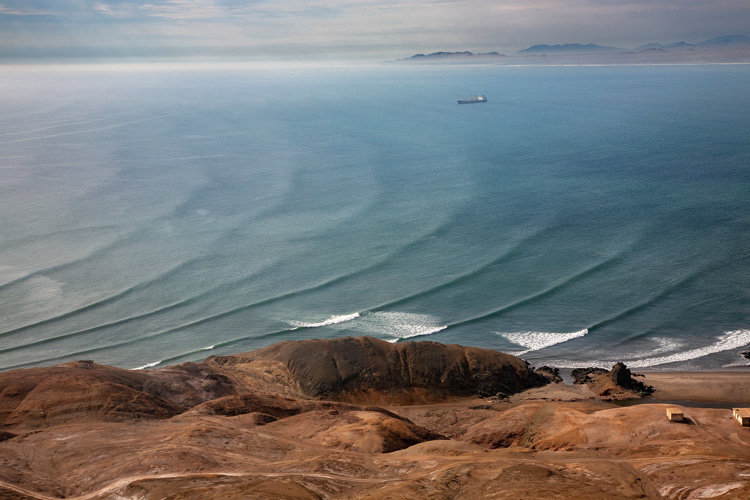
We rarely witness the birth of a wave. Instead, we observe – or experience as surfers – what seems to be moving water carrying energy from distant storms as it is about to crash on our coastlines and beaches.
But there’s a lot going on before a wave arrives near the shore for its last hurrah.
There are five main moments in the life of a wave: the wind blowing on the surface of the water, the initial propagation, the dispersion, the grouping, and the breaking.
We at SurferToday have already dissected, among several wave-related topics, the first (birth) and last stage (breaking) of an ocean wave.
So, what exactly happens in between? How do swells behave after leaving the storm area and before they reach the landmass?
One of the first and most interesting things we need to know is that, in deep water, an ocean swell nearly doesn’t move water – just energy.
In other words, each water particle spins in a tiny circle as a wave passes, ending up where it started. The phenomenon is known as Stokes drift.
How Waves Propagate
So, after forming in the storm’s wake, waves travel away and propagate away from their source.
As they move over long distances, they spread out. This spreading is known as circumferential dispersion.
Imagine the swell starting from a single point and then sharing its energy over a wider front as it moves further.
With every doubling of the distance from the storm center, the wave height drops by about 30 percent. Impressive, isn’t it?
Nevertheless, whenever the wind continues to push over a wide area, the height reduction is a bit less and could be closer to 15-20 percent.
Here’s an example that could be found in the book “Surf Science” by Tony Butt and Paul Russell.
A swell 1,000 kilometers away might have waves reaching five meters high.
By the time it doubles its distance to 2,000 kilometers, the wave height may fall to around 3.5 meters in height due to the energy being spread thinner.
But there’s another event taking place while the swells ride the Ocean Express. It’s called radial dispersion.
The thing is that along with spreading out sideways, swells stretch in the direction they travel.
What happens is that waves with longer distances between their crests (wavelengths) travel faster than those with shorter distances.
Close to the storm, a mix of long and short waves arrives almost together.
As the swell moves on, the longer waves pull ahead while the shorter ones lag behind.
The separation helps create the long, clean lines of waves that surfers so much cherish, many of them in the category of groundswells.

The Magic of Wave Grouping
In the previous chapter, we’ve seen waves of the swell train spreading.
But as swells travel across the ocean, they also naturally form groups, or sets, of waves.
Wave grouping takes place when waves of different wavelengths combine.
So, when the crests of two waves line up, they create a bigger wave, just like 1 plus 1 equals 2. It makes sense, right?
But if a crest meets a trough, the waves can cancel each other out, leading to quieter moments between sets. It’s like -1 plus 1 equals 0.
So, these two phenomena are rightfully called constructive and destructive interference, and they help surfers understand the concept of “wave sets” and “lulls” that so much rule the lineups.

Understanding Wave and Group Speeds
As we’ve learned above, in deep ocean water, every wave moves in a circular motion, and nearly no water is transported over long distances.
Instead, the waves carry energy.
The speed of the energy-carrying swell, known as group speed, is about 0.78 times the wave period (in seconds).
For instance, if the wave period is 15 seconds, the group speed will be 11.7 meters per second, that is, 42.12 kilometers per hour (26.17 miles per hour).
Meanwhile, the individual waves travel at roughly 1.56 times the period.
So again, with a period of 15 seconds, “lonely” waves will move at 23.4 meters per second or 84.24 kilometers per hour (52.34 miles per hour).
As a result, individual ripples could move faster through the group from back to front.
In the end, if we could look from up above in real-time, we would see several events taking place simultaneously on the surface of the ocean: swells of different wavelengths overlapping, spaced-out corduroy lines, shorter, choppier waves near the original fetch, etc.

A Pioneering Swell Tracking Study
In 1948, Cambridge mathematicians Norman Barber and Fritz Ursell conducted one of the first documented swell-tracking studies, measuring ocean waves at Pendeen Lighthouse in Cornwall, England.
Their research confirmed that longer waves travel faster than shorter ones, proving the concept of radial dispersion seen above.
Working with Jack Darbyshire, Ursell further analyzed wave behavior using wave spectra, though their work led to a humorous police encounter due to Ursell’s German accent in troubled times.
Earlier, in 1946, the team developed an analog computer to analyze wave records, helping locate distant storm centers.
Their findings came too late for World War II, even though some of their scientist colleagues did contribute to swell forecasting for D-Day.
Nevertheless, Ursell, Barber, and Darbyshire revolutionized wave forecasting by explaining refraction, seabed friction, and wave energy distribution.
Ursell’s later contributions in fluid dynamics, including the Ursell Number, shaped modern wave theory, making their research truly foundational for oceanography and meteorology.
Words by Luís MP | Founder of SurferToday.com


Leave a Reply